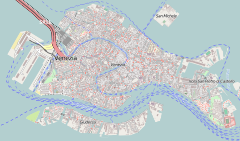Ognissanti, Venice
| Chiesa di Ognissanti Church of Ognissanti | |
|---|---|
 | |
| Religion | |
| Affiliation | Roman Catholic |
| Year consecrated | 1586 |
| Status | Active |
| Location | |
| Location | Dorsoduro, Venice, Italy |
| Geographic coordinates | 45°25′52.07″N 12°19′23.88″E / 45.4311306°N 12.3233000°E |
| Architecture | |
| Type | Church |
| Style | Renaissance |
| Groundbreaking | 1505 |
Ognissanti (Italian: Chiesa di Ognissanti) is a 16th-century Roman Catholic church located in the Dorsoduro sestiere of the Italian city of Venice.
History
In the 15th century, the area of the current church houses a monastery of Cistercian nuns who had moved here from Torcello, the narby islands now largely unhinabitable. In 1472 a hospice was built here with an annexed small church, which is shown in the plan of Venice made by Jacopo de' Barbari. This was replaced from 1505 by the current building, consecrated in 1586.
The church and the nunnery were suppressed by Napoleon Bonaparte in 1807 and left abandoned until Giovan Battista Giustinian turned them as recovieries for aged people. Later the monastery became a hospital, active until the mid-1990s, while the church, contained in the former's perimeter, was used for religious fucntions of recovered people.
Description
The church's façade is divided into three vertical sector, corresponding to the nave and aisles of the interior. The portal has a simple structure, flanked and surmounted by arched, large windows.
The church has a bell tower with a top in Baroque top.
Sources
- Franzoi, Umberto; Di Stefano, Dina (1976). Le chiese di Venezia. Venice: Alfieri editore.


